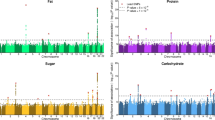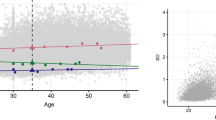Abstract
Human obesity is associated with greater-than-average energy intake, although relatively few studies have tested the heritability of food intake. The present study examined the genetic architecture of measured caloric intake during laboratory test meals in 36 monozygotic and 18 dizygotic twin pairs. A series of analyses tested the hypotheses that (1) there would be a genetic influence on total caloric intake, (2) there would be genes influencing total caloric intake above and beyond those influencing body composition, (3) there would be a phenotypic association between total caloric intake and fat mass above and beyond any genetic influences, and (4) there would be genetic influences on macronutrient intake (i.e., fat, carbohydrate, and protein intake) above and beyond total caloric intake. Results suggested genetic influences on age- and sex-adjusted total caloric intake (24–33% of the variance), although 95% confidence intervals were wide and suggested that “true” heritability estimates might be considerably lower or higher. Caloric intake was influenced by both common and unique environmental factors. Greater-than-average caloric intake was associated with increased adiposity, despite probable genetic influences on both phenotypes. Finally, there was evidence for macronutrient-specific familial influences, although the extent to which they were genetic or environmental in origin could not be teased apart. Results suggest that human obesity may be influenced by behaviors that are themselves genetically regulated. However, further studies are needed to obtain more precise heritability estimates and a better understanding of the conditions under which genetic influences on energy intake emerge.
Similar content being viewed by others
REFERENCES
Akaike, H. (1987). Factor analysis and AIC. Psychometrika 55: 42-48.
Boozer, C. N., Schoenbach, G., and Atkinson, R. L. (1995). Dietary fat and adipsoity: A dose-response relationship in adult male rats fed isocalorically. Am. J. Physiol. 268: E546-450.
Bouchard, C., Tremblay, A., Després, J. P., Nadeau, A., Lupien, P. J., Theriault, G., Dussault, J., Moorjani, S., Pinault, S., and Fournier, G. (1990). The response to long-term overfeeding in identical twins. N. Engl. J. Med. 322:1477-1482.
Bray, G. A. (1996). Mechanisms for development of genetic, hypothalamic, and dietary obesity. In Bray, G. A.; and Ryan, D. H. (eds.), Pennington Center Nutrition Series, Molecular and Genetic Aspects of Obesity, Vol.5, Louisiana State University Press, Baton Rouge, LA, pp. 3-66.
Campfield, L. A., Smith, F. J., Guisez, Y., Devos, R., and Burn, P. (1995). Recombinant mouse OB protein: Evidence for a peripheral signal linking adiposity and central neural networks. Science 269:546-549.
Comuzzie, A. G., and Allison, D. B. (1998). The search for human obesity genes. Science 280:1374-1377.
Comuzzie, A. G., Hixson, J. E., Almasy, L., Mitchell, B. D., Mahaney, M. C., Dyer, T. D., Stern, M. P., MacCluer, J. W., and Blangero, J. (1997). A major quantitative trait locus determining serum leptin levels and fat mass is located on human chromosome 2. Nat. Genet. 15:273-276.
DeCastro, J. M. (1993). Genetic influences on daily intake and meal patterns of humans. Physiol. Behav. 53:777-782.
Fabsitz, R. R., Garrison, R. J., Feinleib, M., and Hjortland, M. (1978). A twin analysis of dietary intake: Evidence for a need to control for possible environmental differences in MZ and DZ twins. Behav. Genet. 8:15-25.
Faith, M. S., Johnson, S. L., and Allison, D. B. (1997). Putting the “behavior” into the behavior genetics of obesity. Behav. Genet. 27:423-439.
Falciglia, G. A., and Norton, P. A. (1994). Evidence for a genetic influence on preference for some foods. J. Am. Diet. Assoc. 94:154-158.
Falconer, D. S. (1990). Introduction to Quantitative Genetics, Longman Group, New York.
Faust, J. (1974). A twin study of personal preferences. J. Biosoc. Sci. 6:75-91.
Goran, M. I. (1997). Genetic influences on human energy expenditure and substrate utilization. Behav. Genet. 27:389-399.
Greene, L. S., Desor, J. A., and Mailer, O. (1975). Heredity and experience: Their relative importance in the development of taste preference in man. J. Comp. Phys. Psychol. 89:279-284.
Heller, R. F., O'Connell, D. L., Roberts, D. C., Allen, J. R., Knapp, J. C., Steele, P. L., and Silove, D. (1988). Lifestyle factors in monozygotic and dizygotic twins. Genet. Epidemiol. 5:311-321.
Heymsfield, S. B., Allison, D. B., Heshka, S., and Pierson, R. N., Jr. (1995). Assessment of human body composition. In Allison, D. B. (ed.), Handbook of Assessment Methods for Eating Behaviors and Weight-Related Problems, Sage, Thousand Oaks, CA, pp. 515-560.
Kissileff, H. R., Klingsberg, G., and VanItallie, T. V. (1980). Universal eating monitor for continuous recording of solid or liquid consumption in man. Am. J. Physiol. 238:R14-R44.
Kissileff, H. R., Gruss, L. P., Thornton, J., and Jordan, H. A. (1984). The satiating efficiency of foods. Physiol. Behav. 32:319-332.
Krondl, M., Coleman, P., Wade, J., and Milner, J. (1983). A twin study examining the genetic influence on food selection. Hum. Nutr. Appl. Nutr. 37A: 189-198.
Lichtman, S. W., Pisarska, K., Berman, E. R., Pestone, M., Dowling, H., Offenbacher, E., Weisel, H., Heshka, S., Matthews, D. E., and Heysmsfield, S. B. (1992). Discrepancy between selfreported and actual caloric intake and exercise in obese subjects. N. Engl. J. Med. 327:1893-1898.
Maes, H., Neale, M. C., and Eaves, L. J. (1997). Genetic and environmental factors in relative body weight and human adiposity. Behav. Genet. 27:325-351.
Martin, N. G., Eaves, L. J., Kearsey, M. J., and Davies, P. (1983). The power of the classical twin study. Heredity 40:97-116.
Meiselman, H. L. (1996).The contextual basis for food acceptance, food choice and food intake: The food, the situation and the individual. In Meiselman, H. L., and MacFie, H. J. H. (eds.), Food Choice Acceptance and Consumption, Blackie Academic Professional, New York, NY, pp. 239-263.
Neale, M. C. (1997). MX: Statistical Modeling, 4th ed., Department of Psychiatry, Virginia Commonwealth University, Richmond.
Neale, M. C., and Cardon, L. R. (1992). Methodology for Genetic Studies of Twins and Families, Kluwer Press, Boston, MA.
Neale, M. C., and Miller, M. B. (1997). The use of likelihood-based confidence intervals in genetic models. Behav. Genet. 27: 113-120.
Norman, R. A., Tataranni, P. A., Pratley, R., Thompson, D. B., Hanson, R. L., Prochazka, M., Baier, L., Ehm, M. G., Sakul, H., Foroud, T., Garvey, W. T., Burns, D., Knowler, W. C., Bennett, P. H., Bogardus, C., and Ravussin, E. (1998). Autosomal genomic scan for loci linked to obesity and energy metabolism in Pima Indians. Am. J. Hum. Genet. 62:659-668.
Pelleymounter, M. A., Cullen, M. J., Baker, M. B., Hecht, R., Winters, D., Boone, T., and Collins, F. (1995). Effects of the obese gene product on body weight regulation in ob/ob mice. Science 269:540-543.
Pi-Sunyer, F. X. (1997). Energy balance: The role of genetics and activity. Ann. N.Y. Acad. Sci. 819:29-36.
Plomin, R. (1998). Using DNA in health psychology. Health Psychol. 17:53-55.
Reed, D. R., Bachmanov, A. A., Beauchamp, G. K., Tordoff, M. G., and Price, R. A. (1997). Heritable variation in food preferences and their contribution to obesity. Behav. Genet. 27:373-387.
Rimer, B. (1997). Toward an improved behavioral medicine. Ann. Behav. Med. 19:6-10.
Rolls, B. J., Kim-Harris, S., Fischman, M. W., Foltin, R. W., Moran, T. H., and Stoner, S. A. (1994). Satiety after preloads with different amounts of fat and carbohydrate: Implications for obesity. Am. J. Clin. Nutr. 60:476-487.
Rosenthal, R., and Rosnow, R. L. (1991). Essentials of Behavioral Research: Methods and Data Analysis, McGraw-Hill, Inc., New York.
Rutter, M., Dunn, J., Plomin, R., Simonoff, E., Pickles, A., Maughan, B., Ormel, J., and Eaves, L. (1997). Integrating nature and nurture: Implications of person-environment correlations and interactions for developmental psychopathology. Dev. Psychopathol. 9:335-364.
Schoeller, D. A., and Fjeld, C. R. (1991). Human energy metabolism: What have we learned from the doubly labeled water method? Annu. Rev. Nutr. 11:355-373.
Wachs, T. D. (1983). The use and abuse of environment in behaviorgenetic research. Child Dev. 54:396-407.
Author information
Authors and Affiliations
Rights and permissions
About this article
Cite this article
Faith, M.S., Rha, S.S., Neale, M.C. et al. Evidence for Genetic Influences on Human Energy Intake: Results from a Twin Study Using Measured Observations. Behav Genet 29, 145–154 (1999). https://doi.org/10.1023/A:1021683716700
Issue Date:
DOI: https://doi.org/10.1023/A:1021683716700




